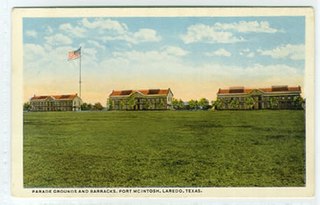
Fort McIntosh was a U.S. Army base in Laredo, Webb County, Texas, that existed from 1849 to 1946.

The Nippon Kan Theatre is a former Japanese theater in Seattle, Washington, United States. Built in 1909 as a hotel, it was boarded up in 1942 during the Japanese American internment, but reopened in 1981 through the restorative efforts of Seattle architect Edward M. Burke and his wife Betty. It is located in the Kobe Park Building at 628 S. Washington Street, in the former Japantown section of Seattle's International District. In 2005 it was sold to ABC Legal Services and was used as converted office space. A replica of the curtain hangs on the wall along with several historic photographs. Its original closure has been attributed to the decreasing number of people of Japanese descent in Seattle.
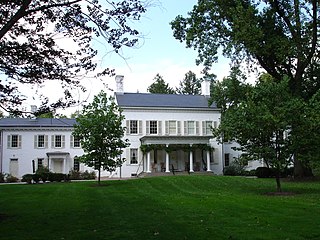
Morven, known officially as Morven Museum & Garden, is a historic 18th-century house at 55 Stockton Street in Princeton, Mercer County, New Jersey, United States. It served as the governor's mansion for nearly four decades in the twentieth century, and has been designated a National Historic Landmark. It is listed on the National Register of Historic Places.

Westland Mansion was the home of Grover Cleveland, the 22nd and 24th President of the United States, from his retirement in 1897 until his death in 1908. The house is located in the historic district of Princeton, New Jersey, and is a National Historic Landmark also known as the Grover Cleveland Home.

The United States Marine Hospital in Louisville, Kentucky, in the Portland neighborhood was built in 1845, and is considered by the National Park Service to be the best remaining antebellum hospital in the United States. Of the seven hospitals built in the mid-19th century by the Marine Hospital Service "for the benefit of sick seamen, boatmen, and other navigators on the western rivers and lakes." It is the only one still standing, even after surviving two tornadoes. The building has been extensively restored to match its appearance in 1899.

Christ Church Cathedral is the cathedral for the Episcopal Diocese of Indianapolis. Christ Church parish was formally organized in 1837. The present-day church building was erected in 1857 on Monument Circle at the center of downtown Indianapolis to replace the parish's first church built on the same site. Designed by architect William Tinsley, the English Gothic Revival-style structure is the oldest church building in Indianapolis and Marion County, Indiana, that has remained in continuous use. It is also the oldest building on Monument Circle. Christ Church is known for its music, especially its pipe organs, one of which was donated by Ruth Lilly, and its professional Choir of Men and Boys and Girls' Choir. The parish is also known for its community service, including an annual strawberry festival fundraiser and other charitable work. Christ Church Cathedral was added to the National Register of Historic Places on July 10, 1973. It is located in the Washington Street-Monument Circle Historic District.
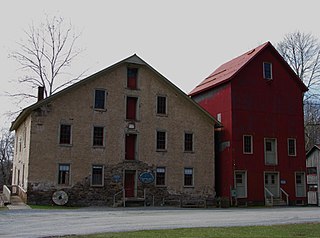
Prallsville is an unincorporated community located along New Jersey Route 29 by the border of Stockton and Delaware Township in Hunterdon County, New Jersey. The Delaware River and Wickecheoke Creek border the community. The Prallsville District was listed on the National Register of Historic Places in 1979.

Dr. Susan LaFlesche Picotte Memorial Hospital, also known as Walthill Hospital or Dr. Susan Picotte Memorial Hospital, is a former hospital building at 505 Matthewson Street in Walthill, Nebraska, on the Omaha Indian Reservation. The hospital was developed by Dr. Susan LaFlesche Picotte (1865–1915), the first female Native American medical doctor. Built with money raised by Picotte from various sources, it was the first hospital for any Indian reservation not funded by government money. It served the community as a hospital until the 1940s, and has had a variety of other uses since. It was declared a National Historic Landmark in 1993.

Community Memorial Hospital is a historic hospital building at 15 Winthrop Avenue in Ayer, Massachusetts. The brick and stone Colonial Revival building was constructed in 1929, and expanded in the 1950s. It was designed by the Fitchburg architectural firm of Haynes & Mason, and was the first hospital building dedicated to serving the town of Ayer. The organization that operated the hospital was created by the merger of the Ayer Hospital Association, founded in 1912, and the Ayer Private Hospital, founded 1924. This organization operated the facility until 1957, when it was merged with the Groton Community Hospital. This group continued to operate the facility until 1971, when it moved to new premises and vacated this building.

This is a list of the National Register of Historic Places listings in San Joaquin County, California.

Stockton Springs Community Church, formerly the Stockton Springs Universalist Church, is a historic church at 20 Church Street in Stockton Springs, Maine. Built in 1853, it is a fine example of transitional Greek Revival-Italianate architecture, and is particularly noted for the trompe-l'œil frescoes on its walls. It was listed on the National Register of Historic Places in 1985.

Walton Grange No. 1454 is a historic Grange building located at 137 Stockton Avenue in Walton in Delaware County, New York, United States. Designed by architects Randall and Gilbert of Walton and built in 1886, it consists of a two-story administration building with an attached gable roofed drill shed. It was occupied from 1886-1896 by the 33rd Separate Company then vacated in 1896 and converted for use as a school and a Grange hall. It was listed on the National Register of Historic Places in 1998 as Walton Grange #1454-Former Armory.

The Hebrew Orphan Asylum is an historic institutional orphanage and former hospital building located in the Mosher neighborhood of Baltimore, Maryland, United States. It has also been known as West Baltimore General Hospital, Lutheran Hospital of Maryland and is currently being redeveloped by Coppin Heights Community Development Corporation to be a Center for Healthcare & Healthy Living.
Built in 1875, the Hebrew Orphan Asylum in Baltimore, Maryland replaced the old Calverton Mansion when a fire destroyed the mansion in 1874. The Hebrew Orphan Asylum, which started in 1872 in the Calverton Mansion depended on donations from people within the Baltimore Jewish community, including the wealthy German Jewish community that had settled within the city. The history of the asylum follows the history of the Jewish community in Baltimore, which increased rapidly with immigration from Europe in the 19th and 20th centuries. The building transitioned to serve as the West Baltimore General Hospital from 1923 through 1950 and finally the Lutheran Hospital of Maryland from 1950 to 1989. While associated structures associated with the Hebrew Orphan Asylum, the West Baltimore General Hospital, and the Lutheran Hospital of Maryland were demolished in 2009, the original four-story brick Romanesque structure still stands.
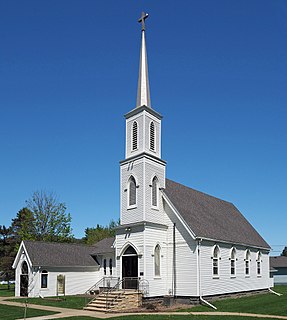
Trinity Episcopal Church is a historic church building in Stockton, Minnesota, United States, constructed in 1859. It is now the Grace Evangelical Lutheran Church and was enlarged with a new wing in 1971. The original section was listed on the National Register of Historic Places in 1984 for having local significance in the themes of architecture and exploration/settlement. It was nominated for its well-preserved Carpenter Gothic architecture and shared importance to a community established by American-born settlers but later dominated by German immigrants.

Stockton Hall is a building on the campus of George Washington University in Washington, D.C.. It was listed on the District of Columbia Inventory of Historic Sites in 1987 and on the National Register of Historic Places in 1991.
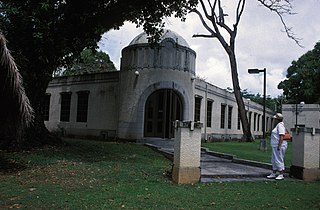
The Japanese Hospital or Saipan Byoin is a historic World War II-era hospital complex on Route 3 in Garapan, a village on the island of Saipan in the Northern Mariana Islands. The three concrete buildings are the largest Japanese-built structures to survive the war. The main hospital building is an L-shaped structure with a domed entrance at the crook of the L. A second, smaller building housed the pharmacy, while the third is an underground circular chamber of unknown purpose. All were in deteriorating condition when surveyed in the early 1970s. The complex has since undergone restoration, and the main hospital building now houses the Northern Mariana Islands Museum.

The former Japanese Hospital building on the island of Rota in the Northern Mariana Islands is one of the few remaining Japanese-era buildings on the island. It is a single-story L-shaped concrete structure. When listed on the National Register of Historic Places in 1981, it was described as being in derelict condition, being little more than the concrete structure, lacking a roof, windows, and most of its woodwork. The window openings are sheltered by typical Japanese concrete canopies. The building was built by the Japanese about 1930, during the South Seas Mandate period; most Japanese-built structures on Rota were destroyed during World War II.

The Stockton Street Historic District covers both sides of Stockton Street, from Railroad Avenue to Summit Street, and a portion of Rogers Avenue in Hightstown, New Jersey. It is notable for its Victorian homes, First Methodist Church, and the Hightstown Civil War monument. It is also significant for its association with the introduction of rail service to New Jersey, as the first railroad in the United States to connect two major cities, New York and Philadelphia, originally ran along what is now Railroad Avenue at the eastern end of the district. In 1832, the John Bull, the first locomotive in the country, provided the first steam-powered passenger rail service in the country, stopping at Stockton Street. In July 2015, Hightstown became a Preserve America community which enhances historic preservation, including the district.

Stockton Community Building, also known as the Trent-Sallee American Legion Post #230, is a historic community centre located at Stockton, Cedar County, Missouri. It was built in 1933-1934 through a grant from the Civil Works Administration. It is a two-story, rectangular building constructed of native limestone in a plain ashlar design.























